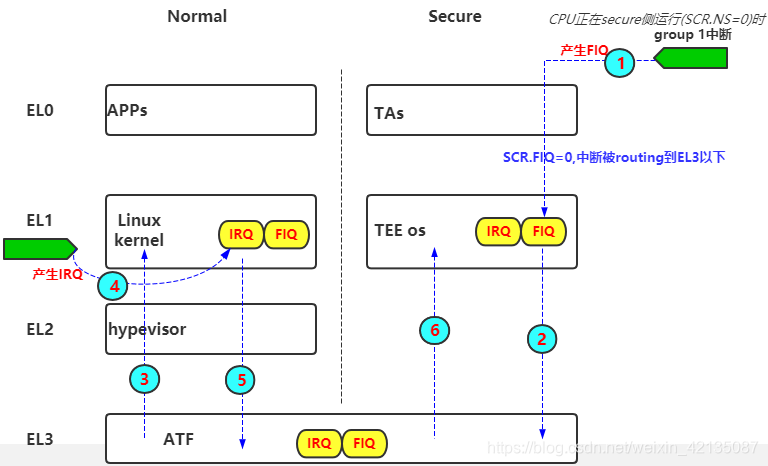快速连接
👉👉👉【精选】ARMv8/ARMv9架构入门到精通-目录 👈👈👈

环境:
linux kernel 4.4, (SCR.IRQ=0、SCR.FIQ=1)
optee 3.6 (SCR.IRQ=0、SCR.FIQ=0)
ARMV8
GICV3
当cpu处于secure侧时,来了一个非安全中断,根据SCR.NS=0/中断在non-secure group1组,cpu interface将会给cpu一个FIQ,(由于SCR.FIQ=0,FIQ将被routing到EL1),跳转至optee的fiq中断异常向量表,
再optee的fiq处理函数中,调用了smc跳转到ATF, ATF再切换至normal EL1(linux), 此时SCR.NS的状态发生变化,根据SCR.NS=1/中断在non-secure group1组,cpu interface会再给cpu发送一个IRQ异常,
cpu跳转至linux的irq中断异常向量表,处理完毕后,再依次返回到ATF---返回到optee
我们从那代码中,依次拆解以上步骤:
在cpu进入TEE之前,CPU是通过optee_open_session()、optee_close_session()、optee_invoke_func()等函数进入TEE,而这些函数都是调用了optee_do_call_with_arg(),在该函数中再调用smc。
optee_do_call_with_arg()函数原型如下:(注意中文注释)
u32 optee_do_call_with_arg(struct tee_context *ctx, phys_addr_t parg)
{
struct optee *optee = tee_get_drvdata(ctx->teedev);
struct optee_call_waiter w;
struct optee_rpc_param param = { };
struct optee_call_ctx call_ctx = { };
u32 ret;
param.a0 = OPTEE_SMC_CALL_WITH_ARG;
reg_pair_from_64(¶m.a1, ¶m.a2, parg);
/* Initialize waiter */
optee_cq_wait_init(&optee->call_queue, &w);
while (true) {
struct arm_smccc_res res;
// 注意,这里调用smc,-->ATF-->TEE
optee->invoke_fn(param.a0, param.a1, param.a2, param.a3,
param.a4, param.a5, param.a6, param.a7,
&res);
// 从TEE回来之后,执行这里(无论是TEE正常返回,还是RPC返回,还是中断切过来的)
// 如果是REE中断导致TEE切过来的,那么这里已经触发irq了,带irq执行完毕后,程序继续从这里往下执行
// 注:REE中断导致的cpu从TEE切过来,也属于RPC返回
if (res.a0 == OPTEE_SMC_RETURN_ETHREAD_LIMIT) {
/*
* Out of threads in secure world, wait for a thread
* become available.
*/
optee_cq_wait_for_completion(&optee->call_queue, &w);
} else if (OPTEE_SMC_RETURN_IS_RPC(res.a0)) {
// 如果是RPC、中断返回走这里, 然后看下optee_handle_rpc()函数原型
param.a0 = res.a0;
param.a1 = res.a1;
param.a2 = res.a2;
param.a3 = res.a3;
optee_handle_rpc(ctx, ¶m, &call_ctx);
// 如果是中断切过来的,optee_handle_rpc()函数相当于啥都没干,程序继续执行上面的while(true),然后又
// 会调用optee->invoke_fn,cpu又切回了TEE
} else {
// 如果是正常返回,走这里,退出optee_do_call_with_arg()函数
ret = res.a0;
break;
}
}
optee_rpc_finalize_call(&call_ctx);
/*
* We're done with our thread in secure world, if there's any
* thread waiters wake up one.
*/
optee_cq_wait_final(&optee->call_queue, &w);
return ret;
}<font color=red size=3>然后我们再看步骤1和步骤2 :</font>在optee中产生FIQ,跳转到FIQ中断向量表,然后调用smc切换到ATF
LOCAL_FUNC elx_irq , :
#if defined(CFG_ARM_GICV3)
native_intr_handler irq
#else
foreign_intr_handler irq
#endif
END_FUNC elx_irq
LOCAL_FUNC elx_fiq , :
#if defined(CFG_ARM_GICV3)
foreign_intr_handler fiq // 在optee运行时,来了REE中断,触发FIQ,程序会调用到这里
#else
native_intr_handler fiq
#endif
END_FUNC elx_fiq然后看下foreign_intr_handler 的具体实现:其实就是将当前进程的一些寄存器和栈寄存器保存,恢复中断模式的寄存器和tmp_stack栈,然后调用smc切换到ATF,其中smdid = TEESMC_OPTEED_RETURN_CALL_DONE
/* The handler of foreign interrupt. */
.macro foreign_intr_handler mode:req
/*
* Update core local flags
*/
ldr w1, [sp, #THREAD_CORE_LOCAL_FLAGS]
lsl w1, w1, #THREAD_CLF_SAVED_SHIFT
orr w1, w1, #THREAD_CLF_TMP
.ifc \mode\(),fiq
orr w1, w1, #THREAD_CLF_FIQ
.else
orr w1, w1, #THREAD_CLF_IRQ
.endif
str w1, [sp, #THREAD_CORE_LOCAL_FLAGS]
/* get pointer to current thread context in x0 */
get_thread_ctx sp, 0, 1, 2
/* Keep original SP_EL0 */
mrs x2, sp_el0
/* Store original sp_el0 */
str x2, [x0, #THREAD_CTX_REGS_SP]
/* store x4..x30 */
store_xregs x0, THREAD_CTX_REGS_X4, 4, 30
/* Load original x0..x3 into x10..x13 */
load_xregs sp, THREAD_CORE_LOCAL_X0, 10, 13
/* Save original x0..x3 */
store_xregs x0, THREAD_CTX_REGS_X0, 10, 13
/* load tmp_stack_va_end */
ldr x1, [sp, #THREAD_CORE_LOCAL_TMP_STACK_VA_END]
/* Switch to SP_EL0 */
msr spsel, #0
mov sp, x1
/*
* Mark current thread as suspended
*/
mov w0, #THREAD_FLAGS_EXIT_ON_FOREIGN_INTR
mrs x1, spsr_el1
mrs x2, elr_el1
bl thread_state_suspend
mov w4, w0 /* Supply thread index */
/* Update core local flags */
/* Switch to SP_EL1 */
msr spsel, #1
ldr w0, [sp, #THREAD_CORE_LOCAL_FLAGS]
lsr w0, w0, #THREAD_CLF_SAVED_SHIFT
str w0, [sp, #THREAD_CORE_LOCAL_FLAGS]
msr spsel, #0
/*
* Note that we're exiting with SP_EL0 selected since the entry
* functions expects to have SP_EL0 selected with the tmp stack
* set.
*/
ldr w0, =TEESMC_OPTEED_RETURN_CALL_DONE
ldr w1, =OPTEE_SMC_RETURN_RPC_FOREIGN_INTR
mov w2, #0
mov w3, #0
/* w4 is already filled in above */
smc #0
b . /* SMC should not return */
.endm然后到了步骤3:看ATF的opteed_smc_handler()函数,我们直接来看case TEESMC_OPTEED_RETURN_CALL_DONE处。
在optee时,触发了FIQ,foreign_intr_handler调用smc,进入ATF后,走这里,这里将恢复linux系统的寄存器,ELR_EL3填充linux侧的PC指针值,SMC_RET4后cpu将切回linux
case TEESMC_OPTEED_RETURN_CALL_DONE:
/*
* This is the result from the secure client of an
* earlier request. The results are in x0-x3. Copy it
* into the non-secure context, save the secure state
* and return to the non-secure state.
*/
assert(handle == cm_get_context(SECURE));
cm_el1_sysregs_context_save(SECURE);
/* Get a reference to the non-secure context */
ns_cpu_context = cm_get_context(NON_SECURE);
assert(ns_cpu_context);
/* Restore non-secure state */
cm_el1_sysregs_context_restore(NON_SECURE);
cm_set_next_eret_context(NON_SECURE);
SMC_RET4(ns_cpu_context, x1, x2, x3, x4);接着又到了步骤4和步骤5:该部分对应的代码就是本篇一开始贴出的optee_do_call_with_arg(), 程序回到次函数后,由于SCR.NS的状态发生了变化,cpu interface会再次给ARM Core发送一个IRQ,此时立即进入了linux kernel的IRQ中断向量表,待中断处理函数执行完毕后。PC再次指向此处,接着也就是下面这段逻辑了
else if (OPTEE_SMC_RETURN_IS_RPC(res.a0)) {
// 如果是RPC、中断返回走这里, 然后看下optee_handle_rpc()函数原型
param.a0 = res.a0;
param.a1 = res.a1;
param.a2 = res.a2;
param.a3 = res.a3;
optee_handle_rpc(ctx, ¶m, &call_ctx);
// 如果是中断切过来的,optee_handle_rpc()函数相当于啥都没干,程序继续执行上面的while(true),然后又
// 会调用optee->invoke_fn,cpu又切回了TEE
} 在optee_handle_rpc()中的OPTEE_SMC_RPC_FUNC_FOREIGN_INTR业务逻辑中,其实啥逻辑都没干,直接返回. 子函数返回后,optee_do_call_with_arg()中的while循环继续执行,optee->invoke_fn()再次将CPU切到ATF。
void optee_handle_rpc(struct tee_context *ctx, struct optee_rpc_param *param,
struct optee_call_ctx *call_ctx)
{
struct tee_device *teedev = ctx->teedev;
struct optee *optee = tee_get_drvdata(teedev);
struct tee_shm *shm;
phys_addr_t pa;
switch (OPTEE_SMC_RETURN_GET_RPC_FUNC(param->a0)) {
case OPTEE_SMC_RPC_FUNC_ALLOC:
shm = tee_shm_alloc(ctx, param->a1, TEE_SHM_MAPPED);
if (!IS_ERR(shm) && !tee_shm_get_pa(shm, 0, &pa)) {
reg_pair_from_64(¶m->a1, ¶m->a2, pa);
reg_pair_from_64(¶m->a4, ¶m->a5,
(unsigned long)shm);
} else {
param->a1 = 0;
param->a2 = 0;
param->a4 = 0;
param->a5 = 0;
}
break;
case OPTEE_SMC_RPC_FUNC_FREE:
shm = reg_pair_to_ptr(param->a1, param->a2);
tee_shm_free(shm);
break;
case OPTEE_SMC_RPC_FUNC_FOREIGN_INTR: //---看下面的英文注释吧,如果是中断切过来的,啥都不干
/*
* A foreign interrupt was raised while secure world was
* executing, since they are handled in Linux a dummy RPC is
* performed to let Linux take the interrupt through the normal
* vector.
*/
break;
case OPTEE_SMC_RPC_FUNC_CMD:
shm = reg_pair_to_ptr(param->a1, param->a2);
handle_rpc_func_cmd(ctx, optee, shm, call_ctx);
break;
default:
pr_warn("Unknown RPC func 0x%x\n",
(u32)OPTEE_SMC_RETURN_GET_RPC_FUNC(param->a0));
break;
}
param->a0 = OPTEE_SMC_CALL_RETURN_FROM_RPC;
}
接下来步骤6 :再次回到了ATF, 进入ATF的opteed_smc_handler()函数中,然后将optee_vectors->fast_smc_entry赋值给ELR_EL3,然后ERET退出ATF,跳转到optee中线程向量表的fast_smc_entry中
if (is_caller_non_secure(flags)) {
/*
* This is a fresh request from the non-secure client.
* The parameters are in x1 and x2. Figure out which
* registers need to be preserved, save the non-secure
* state and send the request to the secure payload.
*/
assert(handle == cm_get_context(NON_SECURE));
cm_el1_sysregs_context_save(NON_SECURE);
/*
* We are done stashing the non-secure context. Ask the
* OPTEE to do the work now.
*/
/*
* Verify if there is a valid context to use, copy the
* operation type and parameters to the secure context
* and jump to the fast smc entry point in the secure
* payload. Entry into S-EL1 will take place upon exit
* from this function.
*/
assert(&optee_ctx->cpu_ctx == cm_get_context(SECURE));
/* Set appropriate entry for SMC.
* We expect OPTEE to manage the PSTATE.I and PSTATE.F
* flags as appropriate.
*/
if (GET_SMC_TYPE(smc_fid) == SMC_TYPE_FAST) {
cm_set_elr_el3(SECURE, (uint64_t)
&optee_vectors->fast_smc_entry);
// linux处理完中断再回TEE时,走这里,将fast_smc_entry地址赋给了ELR_EL3, fast_smc_entry地址是optee中
// fast_smc_entry函数的地址,是optee开机初始化时,传过来的,然后ATF保存到全局变量中了。
}最后,在optee的线程向量表的fast_smc_entry向量中,将恢复optee之前进程的寄存器和PC值,至此整个中断处理 流程完成。
关注"Arm精选"公众号,备注进ARM交流讨论区。



